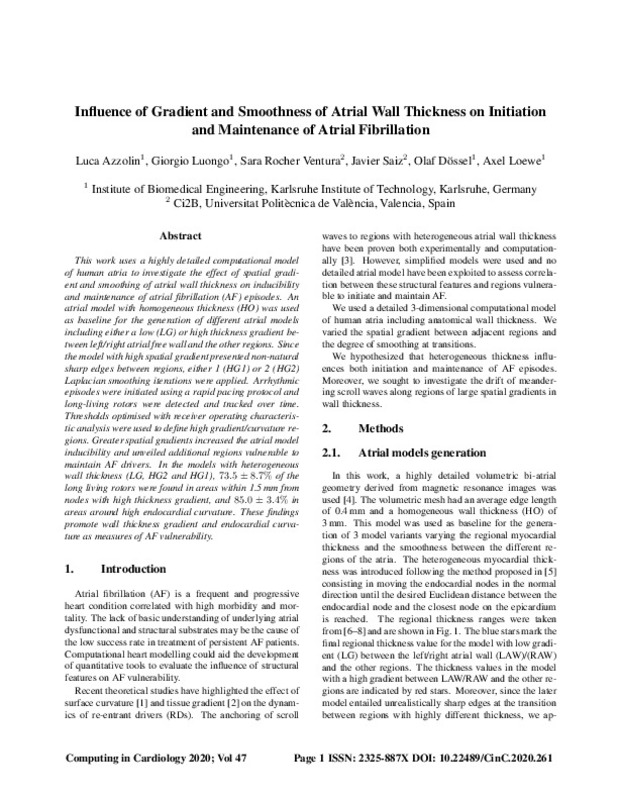JavaScript is disabled for your browser. Some features of this site may not work without it.
Buscar en RiuNet
Listar
Mi cuenta
Estadísticas
Ayuda RiuNet
Admin. UPV
Influence of Gradient and Smoothness of Atrial Wall Thickness on Initiation and Maintenance of Atrial Fibrillation
Mostrar el registro sencillo del ítem
Ficheros en el ítem
| dc.contributor.author | Azzolin, Luca
|
es_ES |
| dc.contributor.author | Luongo, Giorgio
|
es_ES |
| dc.contributor.author | Rocher-Ventura, Sara
|
es_ES |
| dc.contributor.author | Saiz Rodríguez, Francisco Javier
|
es_ES |
| dc.contributor.author | Dossel, Olaf
|
es_ES |
| dc.contributor.author | Loewe, Axel
|
es_ES |
| dc.date.accessioned | 2022-01-18T08:13:13Z | |
| dc.date.available | 2022-01-18T08:13:13Z | |
| dc.date.issued | 2020-09-16 | es_ES |
| dc.identifier.issn | 2325-887X | es_ES |
| dc.identifier.uri | http://hdl.handle.net/10251/179854 | |
| dc.description.abstract | [EN] This work uses a highly detailed computational model of human atria to investigate the effect of spatial gradient and smoothing of atrial wall thickness on inducibility and maintenance of atrial fibrillation (AF) episodes. An atrial model with homogeneous thickness (HO) was used as baseline for the generation of different atrial models including either a low (LG) or high thickness gradient between left/right atrial free wall and the other regions. Since the model with high spatial gradient presented non-natural sharp edges between regions, either 1 (HG1) or 2 (HG2) Laplacian smoothing iterations were applied. Arrhythmic episodes were initiated using a rapid pacing protocol and long-living rotors were detected and tracked over time. Thresholds optimised with receiver operating characteristic analysis were used to define high gradient/curvature regions. Greater spatial gradients increased the atrial model inducibility and unveiled additional regions vulnerable to maintain AF drivers. In the models with heterogeneous wall thickness (LG, HG2 and HG1), 73.5 ± 8.7% of the long living rotors were found in areas within 1.5 mm from nodes with high thickness gradient, and 85.0 ± 3.4% in areas around high endocardial curvature. These findings promote wall thickness gradient and endocardial curvature as measures of AF vulnerability | es_ES |
| dc.description.sponsorship | Research supported by the European Union¿s Horizon 2020 research and innovation programme under the Marie Sk¿odowska-Curie grant agreement No.766082 (MY-ATRIA project) | es_ES |
| dc.language | Inglés | es_ES |
| dc.publisher | IEEE | es_ES |
| dc.relation.ispartof | CinC 2020: Program. Computing in Cardiology, vol. 47 | es_ES |
| dc.rights | Reconocimiento (by) | es_ES |
| dc.subject.classification | TECNOLOGIA ELECTRONICA | es_ES |
| dc.title | Influence of Gradient and Smoothness of Atrial Wall Thickness on Initiation and Maintenance of Atrial Fibrillation | es_ES |
| dc.type | Comunicación en congreso | es_ES |
| dc.type | Artículo | es_ES |
| dc.identifier.doi | 10.22489/CinC.2020.261 | es_ES |
| dc.relation.projectID | info:eu-repo/grantAgreement/EC/H2020/766082/EU/ | es_ES |
| dc.relation.projectID | info:eu-repo/grantAgreement///ACIF%2F2018%2F174//AYUDA PREDOCTORAL GVA-ROCHER VENTURA. PROYECTO: DESARROLLO DE MODELOS COMPUTACIONALES 3D PERSONALIZADOS DE AURICULA PARA LA OPTIMIZACION DEL TRATAMIENTO DE LA FIBRILACION AURICULAR./ | es_ES |
| dc.rights.accessRights | Abierto | es_ES |
| dc.contributor.affiliation | Universitat Politècnica de València. Departamento de Ingeniería Electrónica - Departament d'Enginyeria Electrònica | es_ES |
| dc.description.bibliographicCitation | Azzolin, L.; Luongo, G.; Rocher-Ventura, S.; Saiz Rodríguez, FJ.; Dossel, O.; Loewe, A. (2020). Influence of Gradient and Smoothness of Atrial Wall Thickness on Initiation and Maintenance of Atrial Fibrillation. IEEE. 1-4. https://doi.org/10.22489/CinC.2020.261 | es_ES |
| dc.description.accrualMethod | S | es_ES |
| dc.relation.conferencename | 47th Computing in Cardiology Conference (CinC 2020) | es_ES |
| dc.relation.conferencedate | Septiembre 13-16,2020 | es_ES |
| dc.relation.conferenceplace | Rimini, Italia | es_ES |
| dc.relation.publisherversion | https://doi.org/10.22489/CinC.2020.261 | es_ES |
| dc.description.upvformatpinicio | 1 | es_ES |
| dc.description.upvformatpfin | 4 | es_ES |
| dc.type.version | info:eu-repo/semantics/publishedVersion | es_ES |
| dc.relation.pasarela | S\428834 | es_ES |
| dc.contributor.funder | European Commission | es_ES |








